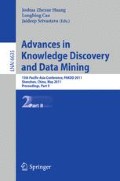Abstract
Cluster tracing algorithms are used to mine temporal evolutions of clusters. Generally, clusters represent groups of objects with similar values. In a temporal context like tracing, similar values correspond to similar behavior in one snapshot in time. Each cluster can be interpreted as a behavior type and cluster tracing corresponds to tracking similar behaviors over time. Existing tracing approaches are designed for datasets satisfying two specific conditions: The clusters appear in all attributes, i.e. fullspace clusters, and the data objects have unique identifiers. These identifiers are used for tracking clusters by measuring the number of objects two clusters have in common, i.e. clusters are traced based on similar object sets.
These conditions, however, are strict: First, in complex data, clusters are often hidden in individual subsets of the dimensions. Second, mapping clusters based on similar objects sets does not reflect the idea of tracing similar behavior types over time, because similar behavior can even be represented by clusters having no objects in common. A tracing method based on similar object values is needed. In this paper, we introduce a novel approach that traces subspace clusters based on object value similarity. Neither subspace tracing nor tracing by object value similarity has been done before.
Access this chapter
Tax calculation will be finalised at checkout
Purchases are for personal use only
Preview
Unable to display preview. Download preview PDF.
References
Aggarwal, C.C.: On change diagnosis in evolving data streams. TKDE 17(5), 587–600 (2005)
Aggarwal, C.C., Han, J., Wang, J., Yu, P.S.: A framework for clustering evolving data streams. In: VLDB, pp. 81–92 (2003)
Aggarwal, C.C., Han, J., Wang, J., Yu, P.S.: A framework for projected clustering of high dimensional data streams. In: VLDB, pp. 852–863 (2004)
Agrawal, R., Gehrke, J., Gunopulos, D., Raghavan, P.: Automatic subspace clustering of high dimensional data for data mining applications. In: SIGMOD, pp. 94–105 (1998)
Böttcher, M., Höppner, F., Spiliopoulou, M.: On exploiting the power of time in data mining. SIGKDD Explorations 10(2), 3–11 (2008)
Ester, M., Kriegel, H.P., Jörg, S., Xu, X.: A density-based algorithm for discovering clusters in large spatial databases with noise. In: KDD, pp. 226–231 (1996)
Gaffney, S., Smyth, P.: Trajectory clustering with mixtures of regression models. In: KDD, pp. 63–72 (1999)
Kalnis, P., Mamoulis, N., Bakiras, S.: On discovering moving clusters in spatio-temporal data. In: Anshelevich, E., Egenhofer, M.J., Hwang, J. (eds.) SSTD 2005. LNCS, vol. 3633, pp. 364–381. Springer, Heidelberg (2005)
Kriegel, H.P., Kröger, P., Zimek, A.: Clustering high-dimensional data: A survey on subspace clustering, pattern-based clustering, and correlation clustering. TKDD 3(1), 1–58 (2009)
Li, Y., Han, J., Yang, J.: Clustering moving objects. In: KDD, pp. 617–622 (2004)
Müller, E., Günnemann, S., Assent, I., Seidl, T.: Evaluating clustering in subspace projections of high dimensional data. In: VLDB, pp. 1270–1281 (2009)
Procopiuc, C.M., Jones, M., Agarwal, P.K., Murali, T.M.: A monte carlo algorithm for fast projective clustering. In: SIGMOD, pp. 418–427 (2002)
Rosswog, J., Ghose, K.: Detecting and tracking spatio-temporal clusters with adaptive history filtering. In: ICDM Workshops, pp. 448–457 (2008)
Spiliopoulou, M., Ntoutsi, I., Theodoridis, Y., Schult, R.: MONIC - modeling and monitoring cluster transitions. In: KDD, pp. 706–711 (2006)
Vlachos, M., Gunopulos, D., Kollios, G.: Discovering similar multidimensional trajectories. In: ICDE, pp. 673–684 (2002)
Yiu, M.L., Mamoulis, N.: Frequent-pattern based iterative projected clustering. In: ICDM, pp. 689–692 (2003)
Author information
Authors and Affiliations
Editor information
Editors and Affiliations
Rights and permissions
Copyright information
© 2011 Springer-Verlag Berlin Heidelberg
About this paper
Cite this paper
Günnemann, S., Kremer, H., Laufkötter, C., Seidl, T. (2011). Tracing Evolving Clusters by Subspace and Value Similarity. In: Huang, J.Z., Cao, L., Srivastava, J. (eds) Advances in Knowledge Discovery and Data Mining. PAKDD 2011. Lecture Notes in Computer Science(), vol 6635. Springer, Berlin, Heidelberg. https://doi.org/10.1007/978-3-642-20847-8_37
Download citation
DOI: https://doi.org/10.1007/978-3-642-20847-8_37
Publisher Name: Springer, Berlin, Heidelberg
Print ISBN: 978-3-642-20846-1
Online ISBN: 978-3-642-20847-8
eBook Packages: Computer ScienceComputer Science (R0)

